
National Fire Plan Success Story
Fire in a Post-Hurricane World
Gulf Islands National Seashore, Florida
National Fire Plan - Fuels Reduction
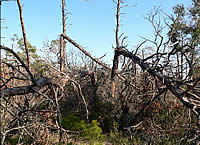
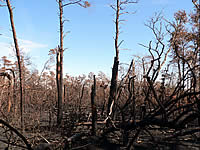
Post-hurricane (top) and post-fire (bottom) fuel load at Gulf Islands. NPS photo by Mark Nicholas.
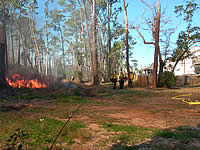
Burning in the wildland-urban interface at Gulf Islands. NPS photo by Lisa McInnis.
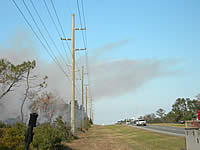
Smoke rises over Highway 98 during a prescribed fire in the wildland-urban interface at Gulf Islands. NPS photo by Lisa McInnis.
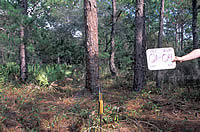
Pre-burn picture of longleaf-dominated area. NPS photo by fire effects monitoring crew, Natchez Trace Parkway.
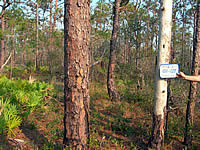
Post-burn picture of longleaf-dominated area; note more open understory. NPS photo by fire effects monitoring crew, Natchez Trace Parkway.
Fiscal year 2007 marked another big accomplishment for fire management at Gulf Islands National Seashore in Florida. The Seashore burned approximately 300 acres of pine- and scrub oak-dominated ecosystems of the Naval Live Oak area in Gulf Breeze, Florida. This is the second year in a row for fuel reduction in an area that has been transformed by tropical storms and hurricanes
Prescribed fire is an important tool for the hazard fuel reduction program at Gulf Islands. This NPS unit has considerable wildland-urban interface and a busy highway that borders much of the NPS land. Burning in these areas presents challenges for burn personnel, but through significant cooperation has been successful for the last two years.
Collaborators include the Great Smoky Mountains and Cumberland Gap Fire Use Modules, Natchez Trace Parkway, Kings Mountain National Military Park, Big South Fork National River and Recreation Area, US Naval Air Station Pensacola, and the Prescribed Fire Training Center. In addition, Gulf Islands is a member in the Gulf Coastal Plain Ecosystem Partnership. This has resulted in cooperation from members including Eglin Air Force Base, Florida Division of Forestry, and The Nature Conservancy.
In addition to the need for hazard fuels reduction, the Naval Live Oaks (NLO) ecosystems of Gulf Islands are fire-dependent. Much of the NLO contains longleaf and slash pine forest, while slightly higher elevation areas are dominated by sand pine and live oaks. Fire suppression in these ecosystems leads to increased shrub layer and undesirable buildup of litter and duff that prevents germination of longleaf pine. In addition, the NLO area is home to the threatened gopher tortoise, which requires patches of bare ground for making burrows and a developed herb and forb layer for forage. Preliminary results from fire effects monitoring of the area suggest decreases in small-diameter trees and percent cover of shrubs.
Using prescribed fire in a post-hurricane, fire-dependent and heavily populated area presents many challenges. However, as a result of the combined efforts of the NPS and other organizations, prescribed burning at Gulf Islands National Seashore is a continued success.
Contact: Lisa McInnis, Fire Ecologist, Phone: (662) 840-7572